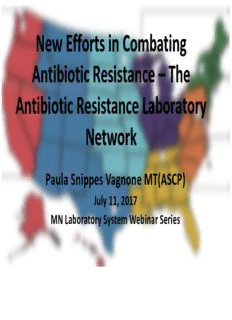
The Antibiotic Resistance Laboratory Network PDF
Preview The Antibiotic Resistance Laboratory Network
New Efforts in Combating Antibiotic Resistance – The Antibiotic Resistance Laboratory Network Paula Snippes Vagnone MT(ASCP) July 11, 2017 MN Laboratory System Webinar Series Objectives Describe the ARLN, including Minnesota’s role and • testing capacity as a regional lab Outline the goals of the ARLN • Review laboratory methods for the detection of • carbapenemases Describe bacterial and fungal resistance threats • 2 Overview of CDC’s New Antibiotic Resistance Laboratory Network 3 Problem: Gaps in State, Regional & National Lab Capacity • Limited state capacity to detect and respond to known or emerging forms of resistance • CDC acts as one of the few sentinel surveillance programs for emerging resistance Highly reliant on an informed laboratorian or clinician to flag unusual resistance • When AR mechanism testing does happen, it is performed at CDC, some state public health labs or at academic/corporate entities that are not connected to public health action • Increasing reliance on culture independent diagnostic testing in clinical labs will limit public health detection of AR 4 Problem: Gaps in State, Regional & National Lab Capacity CARB Action Plan Outlines Milestones to Improve Laboratory Capacity Sub-Objective 2.1.1: Create a regional public health laboratory network that uses standardized testing platforms to expand the availability of reference testing services, characterize emerging resistance patterns and bacterial strains obtained from outbreaks and other sources, and facilitate rapid data analysis and dissemination of information. 5 CDC Antibiotic Resistance Threat Report, September 16, 2013 http://www.cdc.gov/drugresistance/threat-report-2013/pdf/ar-threats-2013-508.pdf#page=14 CDC Antibiotic Resistance Threat Report ESBL CRPA CRE CRA MRSA Microorganisms with a threat level of URGENT: Clostridium difficile, drug-resistant Neisseria gonorrhoeae, and CRE Solution: CDC’s AR Laboratory Network (ARLN) • Transform the national lab infrastructure with regional laboratories and local labs with gold- standard methods and technology • Enhanced testing capacity in all 50 states and five local jurisdictions • Faster detection for rapid and improved public health response • Communication channels to engage clinical laboratory partners • Real-time, actionable data to combat AR threats 9 AR Solutions at Every Level The ARLN ensures more consistent and improved communication, coordination, Healthcare Labs and tracking at all levels every time. • When resistance threats are detected State & Local Health within healthcare facilities or state/local Departments labs, regional labs can provide support to characterize, support response, and track these discoveries. Regional Labs • Flexibility in surveillance testing to focus on the next emerging threat. • CDC’s ARLN team and Programs provide CDC logistics support, subject matter expertise, and tailored solutions. 10
Description: